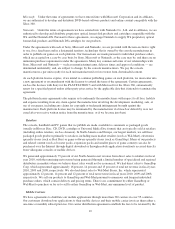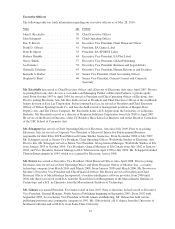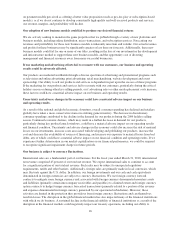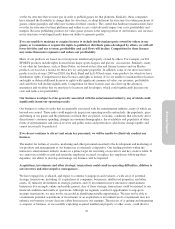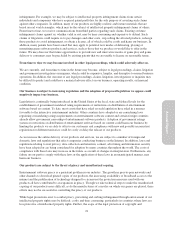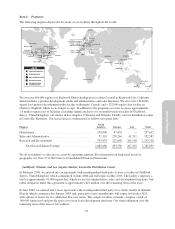Electronic Arts 2010 Annual Report Download - page 98
Download and view the complete annual report
Please find page 98 of the 2010 Electronic Arts annual report below. You can navigate through the pages in the report by either clicking on the pages listed below, or by using the keyword search tool below to find specific information within the annual report.significant amount of resources, as well as our management’s time and focus and may create unforeseen
operating difficulties and expenditures, particularly for a large acquisition. Additional risks and variations of the
foregoing risks we face include:
• The need to implement or remediate controls, procedures and policies appropriate for a public company
in an acquired company that, prior to the acquisition, lacked these controls, procedures and policies,
• Cultural challenges associated with integrating employees from an acquired company or business into our
organization,
• Retaining key employees and maintaining the key business and customer relationships of the businesses
we acquire,
• The need to integrate an acquired company’s accounting, management information, human resource and
other administrative systems to permit effective management and timely reporting,
• The possibility that we will not discover important facts during due diligence that could have a material
adverse impact on the value of the businesses we acquire,
• Potential impairment charges incurred to write down the carrying amount of intangible assets generated
as a result of an acquisition,
• Litigation or other claims in connection with, or inheritance of claims or litigation risks as a result of, an
acquisition, including claims from terminated employees, customers or other third parties,
• Significant accounting charges resulting from the completion and integration of a sizeable acquisition and
increased capital expenditures,
• Significant acquisition-related accounting adjustments, particularly relating to an acquired company’s
deferred revenue, that may cause reported revenue and profits of the combined company to be lower than
the sum of their stand-alone revenue and profits,
• The possibility that the combined company would not achieve the expected benefits, including any
anticipated operating and product synergies, of the acquisition as quickly as anticipated,
• The possibility that the costs of, or operational difficulties arising from, an acquisition would be greater
than anticipated,
• To the extent that we engage in strategic transactions outside of the United States, we face additional
risks, including risks related to integration of operations across different cultures and languages, currency
risks and the particular economic, political and regulatory risks associated with specific countries, and
• The possibility that a change of control of a company we acquire triggers a termination of contractual or
intellectual property rights important to the operation of its business.
Future acquisitions and investments could also involve the issuance of our equity and equity-linked securities
(potentially diluting our existing stockholders), the incurrence of debt, contingent liabilities or amortization
expenses, write-offs of goodwill, intangibles, or acquired in-process technology, or other increased cash and
non-cash expenses, such as stock-based compensation. Any of the foregoing factors could harm our financial
condition or prevent us from achieving improvements in our financial condition and operating performance that
could have otherwise been achieved by us on a stand-alone basis. Our stockholders may not have the opportunity
to review, vote on or evaluate future acquisitions or investments.
We may be subject to claims of infringement of third-party intellectual property rights, which could harm
our business.
From time to time, third parties may assert claims against us relating to patents, copyrights, trademarks, personal
publicity rights, or other intellectual property rights to technologies, products or delivery/payment methods that
are important to our business. Although we believe that we make reasonable efforts to ensure that our products
do not violate the intellectual property rights of others, it is possible that third parties still may claim
20


